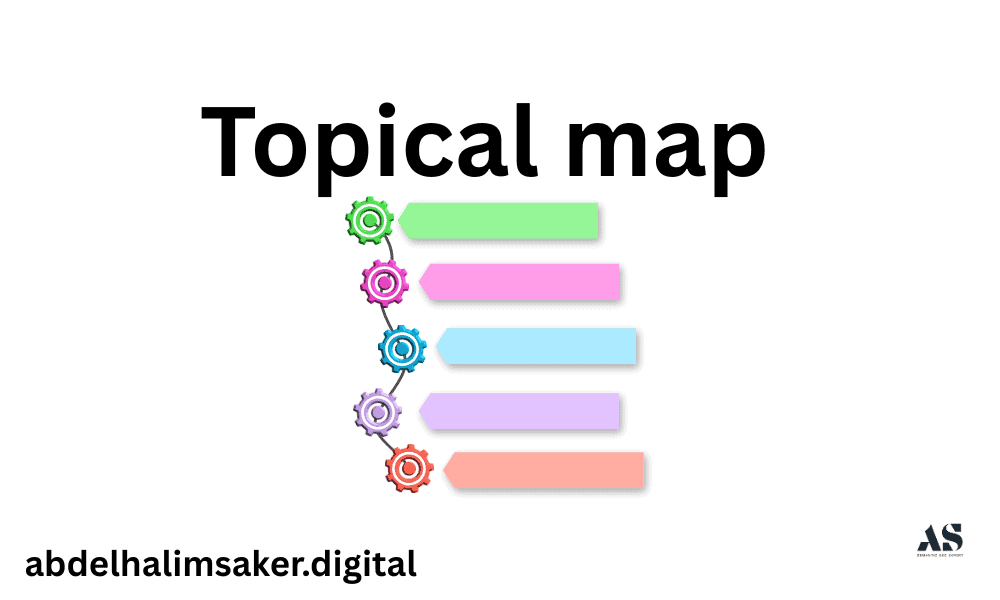
A Topical Map is the semantic architecture that connects entities, attributes, and derived contexts within a specific knowledge domain. It organizes information based on meaning, not just keywords or URLs, allowing search engines and users to understand the relationships between concepts, their properties, and their contextual dependencies.
In Semantic SEO, a topical map functions as a blueprint of understanding. It visualizes how knowledge flows through interconnected entities and how context evolves across content layers.
Purpose and Role of a Topical Map
Why does a topical map matter in SEO and information retrieval?
A topical map helps both search engines and users navigate meaning rather than structure. Instead of relying on hyperlinks or folder paths, it shows how concepts connect.
| Function | Description | Outcome |
|---|---|---|
| Meaning Navigation | Shows how entities interrelate | Improves contextual relevance |
| Predictive Information Retrieval | Helps Google anticipate intent | Reduces retrieval cost |
| Historical Context Building | Tracks evolution of knowledge | Strengthens topical authority |
| User Orientation | Improves UX via semantic pathways | Increases engagement and dwell time |
In predictive information retrieval, a topical map signals which future queries a website is most likely to satisfy. When Google observes consistent topical structure, it pre-ranks content from that domain within its semantic retrieval layer.
A well-designed map also supports historical data accumulation. As new content connects to older topics, the entity’s contextual memory strengthens — improving both ranking stability and semantic trust.
Components of a Topical Map
A topical map consists of two integrated layers: the Core Section and the Outer Section. These reflect authority focus and context expansion — a dual system derived from Koray Tuğberk Gübür’s Topical Authority model.
Core = Main Entities & Attributes
The Core Section defines the main topic’s entities, attributes, and semantic relationships. It represents the most essential meaning unit of a domain.
| Core Element | Function | Example |
|---|---|---|
| Primary Entity | The central concept or object | “Semantic SEO” |
| Attributes | Defining qualities of the entity | “Entity optimization,” “contextual flow” |
| Value Layer | Quantifiable or descriptive property | “Optimizes meaning over keywords” |
| Entity Links | Connect to closely related nodes | “Topical Authority,” “Knowledge Graph” |
The core defines your topical identity. It signals to Google what your site is about, not just what it mentions.
Outer = Informational Context Expansion
The Outer Section provides semantic reinforcement through informational and historical contexts. It expands entity meaning without losing topical coherence.
| Outer Element | Role | Example |
|---|---|---|
| Supportive Subtopics | Add depth and variety | “Entity extraction,” “Schema markup” |
| Temporal Pages | Track evolution of concept | “How Semantic SEO changed with MUM” |
| Use Cases / Examples | Enhance contextual understanding | “Topical Authority case study” |
| Behavioral Connectors | Drive user pathways | Internal links from related subtopics |
Outer coverage creates semantic breadth, while the core ensures semantic precision. Together, they form a balanced topical network — a crucial requirement for EEAT and contextual relevance.
How to Create a Topical Map Step by Step
How do you build a topical map using entity-based SEO principles?
Building a topical map follows a structured, EAV-driven, and attribute-filtered workflow.
Step 1: Define the Central Entity
Identify the main entity — the root concept your site or content cluster revolves around.
Example: “Semantic SEO.”
Determine its attributes and value range:
- Attribute: Focus → Value: Meaning over keywords
- Attribute: Structure → Value: Entity-based model
Step 2: Collect Attributes and Related Entities
Use tools like Google NLP API, InLinks, or Wikipedia categories to extract semantically related entities.
Group these by type:
- Processes: “Entity extraction,” “topic clustering”
- Concepts: “Knowledge Graph,” “Topical Authority”
- Metrics: “Contextual completeness,” “information gain”
Step 3: Cluster Queries by Intent
Categorize search queries around the entity into intent layers:
| Intent Type | Query Example | Map Role |
|---|---|---|
| Informational | “What is a topical map?” | Core explanation |
| Navigational | “Topical map example SEO” | Supporting subtopic |
| Transactional | “Topical map tool” | Outer extension |
Clustering by intent allows you to design a contextual hierarchy that mirrors how users explore meaning.
Step 4: Map Relationships (EAV Model)
Represent data as Entity → Attribute → Value triplets.
Example:
- Topical Map → organizes → entities and contexts
- Semantic SEO → connects → meaning and structure
These semantic triplets form the knowledge network Google’s algorithms interpret as a topical domain.
Step 5: Apply Attribute Filtration
Use attribute filtration to exclude irrelevant or weakly related concepts.
If an attribute does not modify the meaning of your main entity, remove it.
This keeps your topical boundary clear and prevents semantic dilution.
Step 6: Link Nodes by Contextual Relevance
Create connections between nodes based on semantic proximity, not just category.
Example:
- “Entity consolidation” → linked to → “Knowledge Graph optimization.”
- “Topical Authority” → connected to → “Topical Coverage.”
These contextual links signal topic coherence, improving both internal flow and Google’s entity understanding.
Step 7: Visualize the Map
Use graph visualization tools (Neo4j, Miro, MindMeister) to render the connections.
Visualizing relationships helps maintain macro and micro semantic balance — ensuring every entity connects back to the main concept.
Contextual Hierarchy and Flow in Maps
How should you organize the semantic hierarchy in a topical map?
A contextual hierarchy arranges entities and subtopics according to their semantic weight and dependency level.
Macro vs. Micro Semantics
| Level | Description | Example Node |
|---|---|---|
| Macro Context | High-level concept defining the cluster | “Semantic SEO” |
| Meso Context | Intermediary connection between concepts | “Topical Coverage,” “Topical Authority” |
| Micro Context | Specific entities or use cases | “Schema markup,” “entity extraction” |
The flow between nodes must reflect information inheritance.
For example:
Semantic SEO → includes → Topical Authority → depends on → Topical Coverage → generates → Historical Data.
That flow tells Google how knowledge builds progressively — a process essential for predictive indexing and contextual ranking stability.
Maintaining Contextual Flow
- Start from core nodes and move outward.
- Avoid disconnected clusters (they create semantic noise).
- Use descriptive anchors in internal links that reflect entity meaning (not just anchor keywords).
Example:
Instead of “click here,” use “explore entity-based optimization.”
This enhances semantic traceability, allowing search engines to understand concept lineage across your website.
Example of a Topical Map in Action
What does a topical map look like when applied to Semantic SEO?
Below is an abstract flow showing how entities interconnect semantically:
Semantic SEO
├── Topical Authority
│ ├── Behavioral Validation
│ ├── Query Path Reinforcement
│ └── EEAT Integration
├── Topical Coverage
│ ├── Core and Peripheral Contexts
│ ├── Entity Co-occurrence
│ └── Context Vectors
├── Knowledge Graph
│ ├── Entity Consolidation
│ ├── Structured Data (Schema.org)
│ └── Predictive Indexing
└── Historical Data
├── Engagement Metrics
├── Query Reinforcement
└── Predictive IR
Semantic Triplet Example:
- Semantic SEO → requires → Topical Authority
- Topical Authority → depends on → Topical Coverage
- Topical Coverage → produces → Historical Data
- Historical Data → feeds → Predictive IR
This chain creates a closed semantic system, where every entity supports another in meaning and retrieval performance.
Application in Practice
- Central Entity: Semantic SEO
- Cluster Topics: Topical Authority, Topical Coverage, Knowledge Graphs
- Supportive Entities: Schema, RankBrain, MUM, Entity Extraction
- Behavioral Layer: Query Paths, User Engagement
- Predictive Layer: Historical Validation, Information Retrieval
This structure guides Google to interpret your website as a knowledge ecosystem rather than a collection of isolated articles.
How Topical Maps Support EEAT and Knowledge Graph Integration
A topical map directly strengthens EEAT signals and entity recognition.
- Expertise: Shown through complete coverage and logical structure.
- Experience: Proven through case studies and temporal data.
- Authoritativeness: Reinforced by internal semantic coherence.
- Trustworthiness: Validated by external links to aligned entities.
The Knowledge Graph reads these entity relationships as trust hierarchies, recognizing your site as an entity-level contributor.
When topical maps are internally consistent, search engines can:
- Identify your domain entity.
- Associate it with related topical nodes.
- Predictively retrieve your content for future semantic queries.
The Strategic Role of Topical Maps in Long-Term SEO
A topical map is not a static model; it’s a dynamic knowledge framework.
As your site evolves, new nodes (pages, entities, or events) integrate into the existing semantic system, forming historical continuity.
This enables:
- Stable rankings during core updates (due to entity resilience).
- Cross-topic authority growth (through semantic bridge expansion).
- Higher SERP recall (from predictive indexing advantages).
Semantic Chain Representation
Topical Map → structures → Knowledge Representation → improves → Semantic Indexing → enhances → Query Responsiveness.
In simple terms, the better your topical map, the easier it becomes for Google to interpret, rank, and trust your content.
